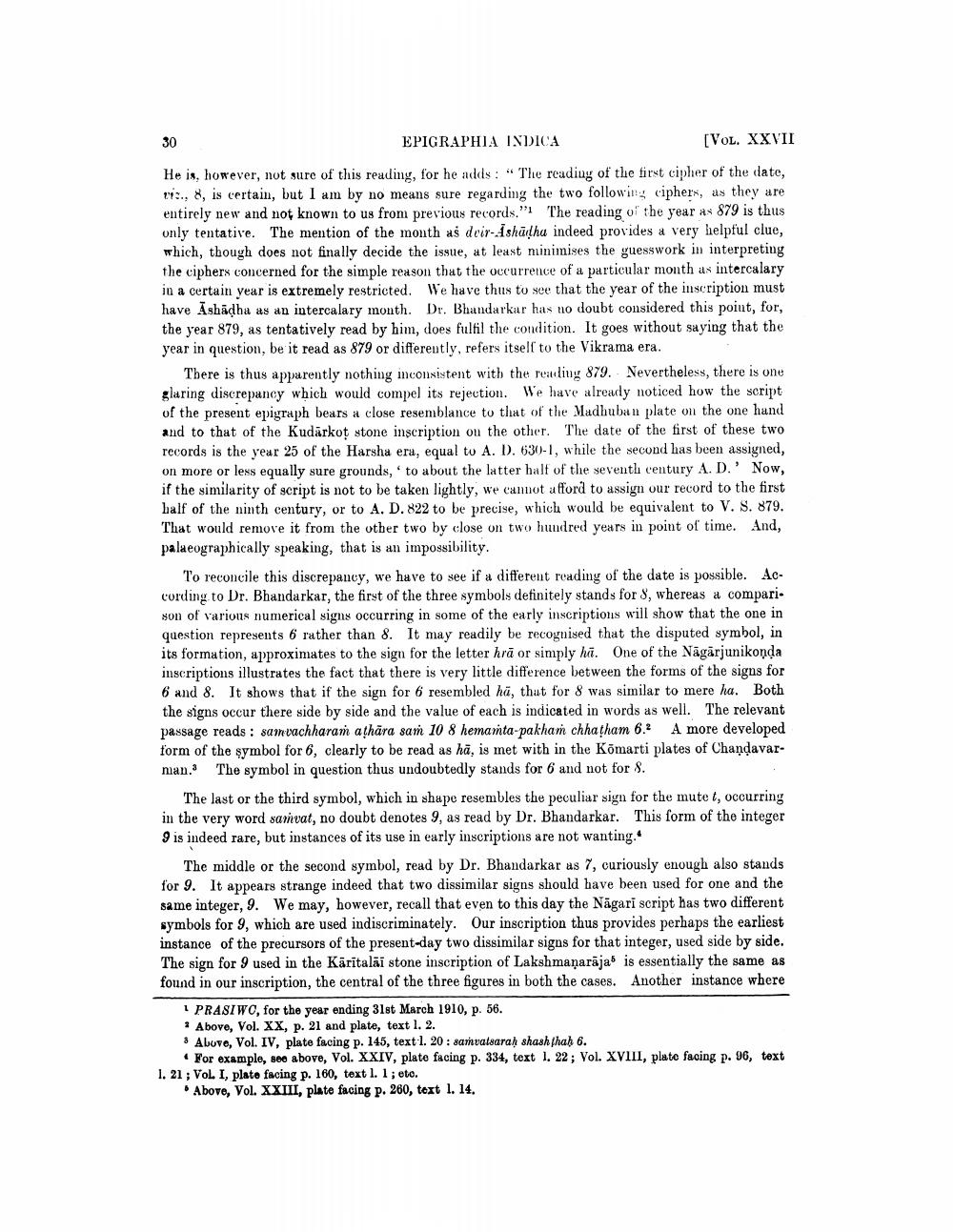________________
EPIGRAPHIA INDICA
(VOL. XXVII
He is, however, not sure of this reading, for he adds: " The reading of the tirst cipher of the date, 19:., 8, is certain, but I am by no means sure regarding the two following ciphers, as they are entirely new and not known to us from previous records." The reading of the year as 879 is thus only tentative. The mention of the month as doir-.Ishādha indeed provides a very helpful clue, which, though does not finally decide the issue, at least minimises the guesswork in interpreting the ciphers concerned for the simple reason that the occurrence of a particular month as intercalary in a certain year is extremely restricted. We have thus to see that the year of the inscription must have Ashādha as an intercalary month. Dr. Bhandarkar has no doubt considered this point, for, the year 879, as tentatively read by him, does fulfil the condition. It goes without saying that the year in question, be it read as 879 or differently, refers itself to the Vikrama era.
There is thus apparently nothing inconsistent with the reading 879. Nevertheless, there is one glaring discrepancy which would compel its rejection. We have already noticed how the script of the present epigraph bears a close resemblance to that of the Madhuban plate on the one hand and to that of the Kudārkot stone inscription on the other. The date of the first of these two records is the year 25 of the Harsha era, equal to A. D. 630-1, while the second has been assigned, on more or less equally sure grounds, to about the latter half of the seventh century A. D.'Now, if the similarity of script is not to be taken lightly, we cannot afford to assign our record to the first half of the ninth century, or to A. D. 822 to be precise, which would be equivalent to V. S. 879. That would remove it from the other two by close on two hundred years in point of time. And, palaeographically speaking, that is an impossibility.
To reconcile this discrepancy, we have to see if a different reading of the date is possible. According to Dr. Bhandarkar, the first of the three symbols definitely stands for 8, whereas a comparison of various numerical signs occurring in some of the early inscriptions will show that the one in question represents 6 rather than 8. It may readily be recognised that the disputed symbol, in its formation, approximates to the sign for the letter hrā or simply hi. One of the Nägärjunikonda inscriptions illustrates the fact that there is very little difference between the forms of the signs for 6 and 8. It shows that if the sign for 6 resembled hā, that for 8 was similar to mere ha. Both the signs occur there side by side and the value of each is indicated in words as well. The relevant passage reads : samvachharam athāra sam 10 8 hemanta-pakham chhatham 6.2 A more developed form of the symbol for 6, clearly to be read as hā, is met with in the Kōmarti plates of Chandavarman. The symbol in question thus undoubtedly stands for 6 and not for 8.
The last or the third symbol, which in shape resembles the peculiar sign for the mutet, occurring in the very word sarivat, no doubt denotes 9, as read by Dr. Bhandarkar. This form of the integer 9 is indeed rare, but instances of its use in early inscriptions are not wanting.
The middle or the second symbol, read by Dr. Bhandarkar as 7, curiously enough also stands for 9. It appears strange indeed that two dissimilar signs should have been used for one and the same integer, 9. We may, however, recall that even to this day the Nägari script has two different symbols for 9, which are used indiscriminately. Our inscription thus provides perhaps the earliest instance of the precursors of the present-day two dissimilar signs for that integer, used side by side. The sign for 9 used in the Karitalãi stone inscription of Lakshmanarājas is essentially the same as found in our inscription, the central of the three figures in both the cases. Another instance where
1 PRASIWO, for the year ending 31st March 1910, p. 56. * Above, Vol. XX, p. 21 and plate, text 1. 2. * Abuvo, Vol. IV, plate facing p. 145, text l. 20: samvatsarah shash shah 6.
. For example, seo above, Vol. XXIV, plate facing p. 334, text I. 22; Vol. XVIII, plato facing p. 96, text 1. 21; VOL. I, plato facing p. 160, text l. 1; eto.
. Abovo, Vol. XXIII, plate facing p. 260, text I. 14.




